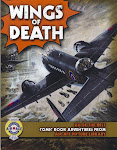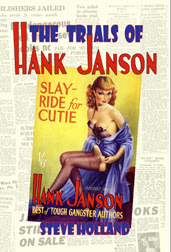 Woppit made his debut on 28 March 1953, in the very first issue of Robin, a weekly comic aimed at very young boys and girls. It was published by Hulton Press, who had already enjoyed considerable success with their boy's adventure comic Eagle, and led to their targeting the female audience with Girl. This was followed by Robin which was published every Monday and was extremely popular, due in part to the 'Andy Pandy' strip based on the Watch With Mother series that appeared on the front cover in colour. Woppit's strip was printed inside and, since he wasn't a TV star, he was only ever printed in black and white throughout his fourteen year career.
Woppit made his debut on 28 March 1953, in the very first issue of Robin, a weekly comic aimed at very young boys and girls. It was published by Hulton Press, who had already enjoyed considerable success with their boy's adventure comic Eagle, and led to their targeting the female audience with Girl. This was followed by Robin which was published every Monday and was extremely popular, due in part to the 'Andy Pandy' strip based on the Watch With Mother series that appeared on the front cover in colour. Woppit's strip was printed inside and, since he wasn't a TV star, he was only ever printed in black and white throughout his fourteen year career. 'The Story of Woppit' began when the little teddy bear fell out of his owner's pram and was left behind on a countryside road. Things looked bleak for the abandoned toy but, as he sat there, lost and alone, along came a little shaggy donkey called Mokey. The pair became instant friends and decided to travel together, exploring the countryside. Later on they were joined by Tiptop, a scarecrow and the three settled down to live at the farmhouse of Mrs. Bumble, where they helped with the chores and continued to have fun learning about the plants and animals.
'The Story of Woppit' began when the little teddy bear fell out of his owner's pram and was left behind on a countryside road. Things looked bleak for the abandoned toy but, as he sat there, lost and alone, along came a little shaggy donkey called Mokey. The pair became instant friends and decided to travel together, exploring the countryside. Later on they were joined by Tiptop, a scarecrow and the three settled down to live at the farmhouse of Mrs. Bumble, where they helped with the chores and continued to have fun learning about the plants and animals. To begin with, 'The Story of Woppit' started as a half-page strip, with the story written a few lines at a time beneath each illustration. The illustrator at that time remains unknown but he or she rendered the strip in a fairly realistic style with wash and ink. Later, in 1961 the strip expanded to two pages and was illustrated by Roland Davies, whose style was more cartoony. Tiptop changed from a real scarecrow made of two sticks and a turnip head to a more human looking figure with two legs while Mokey looked more like a stuffed Spanish souvenir, minus the straw hat! Woppit himself remained pretty much the same, having always been a rather odd looking teddy - with his pointed ears and prominent snout he sometimes looked more like Winnie the Pooh's pal Piglet. However he was always a kindly and amiable little soul who liked to do good deeds, such as sending a Valentine card to cheer up a lonely old lady. 'The Story of Woppit' came to an end in 1967, although Robin continued for quite a few years longer.
To begin with, 'The Story of Woppit' started as a half-page strip, with the story written a few lines at a time beneath each illustration. The illustrator at that time remains unknown but he or she rendered the strip in a fairly realistic style with wash and ink. Later, in 1961 the strip expanded to two pages and was illustrated by Roland Davies, whose style was more cartoony. Tiptop changed from a real scarecrow made of two sticks and a turnip head to a more human looking figure with two legs while Mokey looked more like a stuffed Spanish souvenir, minus the straw hat! Woppit himself remained pretty much the same, having always been a rather odd looking teddy - with his pointed ears and prominent snout he sometimes looked more like Winnie the Pooh's pal Piglet. However he was always a kindly and amiable little soul who liked to do good deeds, such as sending a Valentine card to cheer up a lonely old lady. 'The Story of Woppit' came to an end in 1967, although Robin continued for quite a few years longer. But Woppit hadn't made his final exit yet. His popularity in those days is not as easy to gauge as Andy Pandy's but he must have had some fans for, in 1956, Merrythought produced a Woppit teddy bear. The bears were 9 inches tall, and made of brown plush with blue felt inner ears and matching shoes and the red felt jacket. Woppit only appeared in the Merrythought catalogue for one year and the bears produced are extremely rare today.
But Woppit hadn't made his final exit yet. His popularity in those days is not as easy to gauge as Andy Pandy's but he must have had some fans for, in 1956, Merrythought produced a Woppit teddy bear. The bears were 9 inches tall, and made of brown plush with blue felt inner ears and matching shoes and the red felt jacket. Woppit only appeared in the Merrythought catalogue for one year and the bears produced are extremely rare today. One of them at least was to have an extremely interesting life history -- as the mascot of Donald Campbell, famed land and water speed record breaker.
One of them at least was to have an extremely interesting life history -- as the mascot of Donald Campbell, famed land and water speed record breaker.No-one is quite sure how Campbell acquired his little friend, and theories range from his being a gift from Campbell's wife to a publicity gimmick dreamed up by his manager. Another version, mentioned in Sally Morris and Jan Hallwood's Living With Eagles, is that Campbell was given the bear by Peter Barker, who was in charge of merchandising for the Hulton children's paper. Campbell was pictured with his bear in Robin in August 1959.
Woppit travelled with Donald on all of his record breaking attempts in the UK and the US, and together they broke the world water speed record in Australia in 1964, achieving 276.3 mph. All of Donald Campbell's cars and boats were named 'Bluebird' and Woppit had a little bluebird badge sewn on his jacket to mark his role as official mascot. He also had a slight name change, always being referred to as 'Mr. Whoppit' by Campbell; he is often called by this name even today.
 Three years later in 1967, Donald Campbell attempted to break the water speed record again, this time on Coniston Water in the Lake District. Mr. Whoppit was accompanying him in the cockpit as usual, but this time disaster struck -- the Bluebird somersaulted and capsized at 300 mph. "She's tramping... the water's not good... I can't see much... I'm going... I'm on my back... I'm gone." These were Campbell's last words over the radio, before he and his mascot overturned with the Bluebird and plunged deep into the waters of the lake. Campbell's body was never found, but during the search, rescuers found Mr. Whoppit, drenched but relatively unharmed, floating on the surface of the lake.
Three years later in 1967, Donald Campbell attempted to break the water speed record again, this time on Coniston Water in the Lake District. Mr. Whoppit was accompanying him in the cockpit as usual, but this time disaster struck -- the Bluebird somersaulted and capsized at 300 mph. "She's tramping... the water's not good... I can't see much... I'm going... I'm on my back... I'm gone." These were Campbell's last words over the radio, before he and his mascot overturned with the Bluebird and plunged deep into the waters of the lake. Campbell's body was never found, but during the search, rescuers found Mr. Whoppit, drenched but relatively unharmed, floating on the surface of the lake.After this tragic accident, Mr. Whoppit was given to Campbell's daughter Gina but his days as 'The World's Fastest Teddy' were not yet over. Gina was continue the record breaking tradition set by her father and grandfather, with Mr. Whoppit once again taking his position as mascot in the cockpit. Fate seemed to repeat itself when during one of Gina's water speed attempts, her Bluebird also capsized at 122 mph. Fortunately both she and Mr. Whoppit escaped uninjured and eventually they both retired for a more sedate lifestyle, Gina opening a small restaurant on the South Coast with Mr. Whoppit placed on display for the visitors to see.
In December 1995, Gina placed many items of Campbell family memorabilia in auction including Mr. Whoppit who, surprisingly, didn't reach his reserve price despite his interesting history. Still, perhaps he would have preferred to stay in the family with whom he had shared so many fur-raising adventures. At least he could console himself with the thought that the Nineties has a whole new generation of Mr. Whoppits, courtesy of his creators Merrythought. Following the success of their replicas of the 'Titanic Bear', the company decided that he would be perfect for their next limited edition series of a bear with a history behind him. As well as referring back to their original Woppit patterns from the Fifties, the designers even visited Mr. Whoppit himself to ensure that they captured his likeness exactly. The result was 5,000 little relatives exactly like their forebears, which all came complete with a presentation box containing Mr. Whoppit's life story with the Campbells.
 Woppit has always maintained a low profile compared to other, more famous characters of the bear world, yet he has managed to avoid being lost altogether in the mists of time; although his time in the limelight was brief, it was more spectacular and tragic than anything Rupert or Paddington ever endured. Whether as the lost little bear in Robin or the hero at the helm of the Bluebird, this is one bear who won't be forgotten.
Woppit has always maintained a low profile compared to other, more famous characters of the bear world, yet he has managed to avoid being lost altogether in the mists of time; although his time in the limelight was brief, it was more spectacular and tragic than anything Rupert or Paddington ever endured. Whether as the lost little bear in Robin or the hero at the helm of the Bluebird, this is one bear who won't be forgotten.
























































































